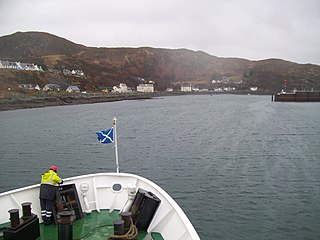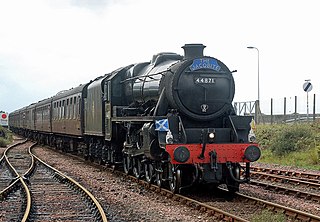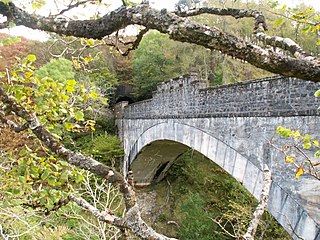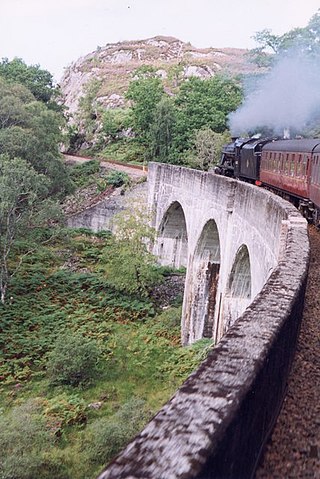
Mallaig is a port in Morar, on the west coast of the Highlands of Scotland. It faces Skye from across the Sound of Sleat. The local railway station is the terminus of the West Highland Line, and the town is linked to Fort William by the A830 road – the "Road to the Isles".

Glenfinnan is a hamlet in Lochaber area of the Highlands of Scotland. In 1745 the Jacobite rising began here when Prince Charles Edward Stuart raised his standard on the shores of Loch Shiel. Seventy years later, the 18 m (60 ft) Glenfinnan Monument, at the head of the loch, was erected to commemorate the historic event.

The West Highland Line is a railway line linking the ports of Mallaig and Oban in the Scottish Highlands to Glasgow in Central Scotland. The line was voted the top rail journey in the world by readers of independent travel magazine Wanderlust in 2009, ahead of the notable Trans-Siberian line in Russia and the Cuzco to Machu Picchu line in Peru. The ScotRail website has since reported that the line has been voted the most scenic railway line in the world for the second year running.

The A830, also known as the Road to the Isles is a major road in Lochaber, Scottish Highlands. It connects the town of Fort William to the port of Mallaig.

Loch Shiel is a freshwater loch situated 20 kilometres (12 mi) west of Fort William in the Highland council area of Scotland. At 28 kilometres long it is the 4th longest loch in Scotland, and is the longest to have retained a natural outflow without any regulation of its water level, being 120 m (393 ft) deep. Its nature changes considerably along its length, being deep and enclosed by mountains in the north east and shallow surrounded by bog and rough pasture in the south west, from which end the 4 km River Shiel drains to the sea in Loch Moidart near Castle Tioram.

The West Highland Railway was a railway company that constructed a railway line from Craigendoran to Fort William and Mallaig. The line was built through remote and difficult terrain in two stages: the section from Craigendoran to Fort William opened in 1894, with a short extension to Banavie on the Caledonian Canal opening in 1895.
The Mallaig Extension Railway is a railway line in Highland, Scotland. It runs from Banavie Junction (New) on the Banavie Pier branch of the West Highland Railway to Mallaig. The previous "Banavie Junction" closer to Fort William was renamed "Mallaig Junction" upon opening of the Mallaig Extension Railway. The line is still open as part of the West Highland Line.

Ardmolich and Kinlochmoidart are settlements at the east head of Loch Moidart in the Moidart region, Highland, Scotland and are in the Scottish council area of Highland.

Inverness-shire or the County of Inverness is a historic county, registration county and lieutenancy area of Scotland. Covering much of the Highlands and Outer Hebrides, it is Scotland's largest county, though one of the smallest in population, with 67,733 people or 1.34% of the Scottish population.

Sgùrr Thuilm is a mountain in the Glenfinnan area of the Highlands of Scotland. It stands at the head of Glen Finnan approximately 7 kilometres (4 mi) north of Loch Shiel.

The Jacobite is a steam locomotive-hauled tourist train service that operates over part of the West Highland Line in Scotland. It has been operating under various names and with different operators every summer since 1984. It has played an important role in sustaining a scenic route.

The River Morar is a river that flows from Loch Morar in the west Highlands of Scotland. It flows from the western end of the loch to the estuary of Morar Bay, an inlet of the Sound of Sleat. It is one of Scotland's shortest rivers, and is known for its white sands beaches where it flows through Morar Bay.

The Morar Railway Viaduct is a railway viaduct that carries the West Highland Line over the River Morar.

The Loch nan Uamh Viaduct is a railway viaduct in Scotland that carries the West Highland Line.

The Borrodale Viaduct is a railway viaduct that carries the West Highland Line over the Borrodale Burn.

The Arnabol Viaduct carries the West Highland Line over the Arnabol Burn.

The Larichmore Viaduct is a railway viaduct in Scotland that carries the West Highland Line over the Brunery Burn.
Glen Finnan is a glen (valley) in Lochaber, Highland, Scotland, located at the foot of Streap in the Northwest Highlands mountain range. The River Finnan, which flows into Loch Shiel, flows the entire length of the valley. The Sgùrr Thuilm mountain stands at the head of Glen Finnan.

The River Finnan is a river in Highland, Scotland that flows the Glen Finnan glen (valley). Rising from the waters of two streams near Corryhully, one named Allt a' Chaol Ghlinne, the River Finnan drains into Loch Shiel. It flows underneath the Glenfinnan Viaduct at Glenfinnan.

Dubh Lighe is a 2-kilometre (1.2 mi) long river in Lochaber, Highland, Scotland that flows the Gleann Dubh Lighe glen (valley), before flowing into Loch Eil, itself giving waters to Loch Linnhe.






















